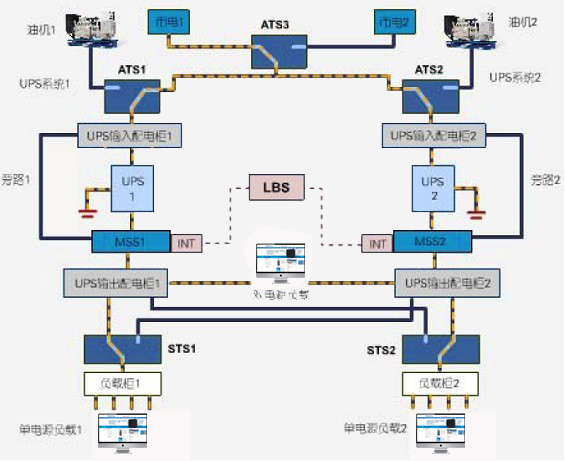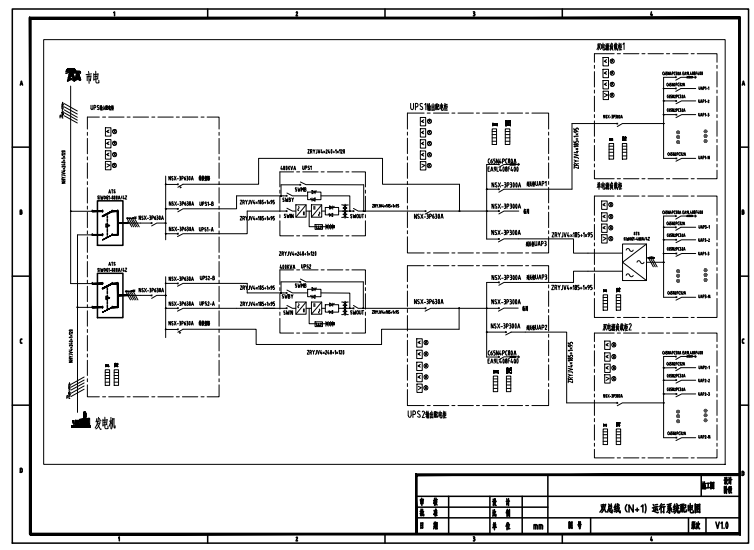·Application Fields:
■Communication systems;
■Financial systems;
■Industrial automation systems;
■Internet Data Center (IDC);
■Media Data Center (MDC);
■Other key loads system.
·Characteristics:
■High usability: Dual Bus (N+1) system can perfectly solve the maintenance problem of single UPS system;
■High reliability: Reducing the fault possibility of input and output of power supplying system to provide the reliable supply protection for the key loads;
■High fault-tolerance function: Non "bottleneck fault"point, there is no bottleneck risk in any node of the whole UPS power supplying system;
■High anti-interference: It can eliminate the "supply interference'"as much as possible whatever it is from the main power or UPS itself that include conducted interference and radiated interference.
·Overview of Dual Bus (N+1) Solution:
The internet data center (IDC) and media data center (MDC) are the regulation and control centers of high-speed internet. Users have an ultra-high demand for their timeliness of remote processing, storage and transmission for information resources (data, voice and image).
Just a few seconds of the "stop" will bring the immeasurable losses for the safe operation of entire Internet and operation of users. What's worse, it can cause the serious damages for the social and economic activities. Therefore, the IDC must provide value added services of information resource featured as continuous high-speed for 365×24 hours, safe and reliable.
For this purpose, from the perspective of design principle, the whole power supply system of IDC has to adopt redundant power supplying solution of high "fault-tolerance" function to ensure that whatever the main power electrical network or inverter of "double-conversion online UPS " fails and fuse burns out or the breaker trips the inverter of online type UPS will supply the power to the internet devices, it shouldn't be powered by main power or emergency backup generators through AC bypass. Because only inverter of online UPS is likely to provide the load of users with high-quality sine power with both stable voltage, non- frequency discontinuity, non-interference, minimum waveform distortion.
For the off-line UPS including backup UPS and online interactive UPS, they mainly adjust the voltage of input power supply and do not "substantively" improve the frequency jitter of input voltage, all kinds of supply interference and voltage distortion. That means there is no "bottleneck" fault risk in the whole power supplying system, so it must be configured with UPS redundant power supplying system of the high "fault-tolerance" function. In other words, even if some "components" occasionally fails during the operation of UPS power supplying system, the whole UPS power supplying system must still be able to run as usual.
According to the technological development level of current UPS industry, it is advisable to choose UPS redundant power supplying system of the "dual bus input" and "dual bus output" power supplying functions. It is composed of the following several power supply systems:
1)Dual bus input power supplying system
The basic configurations of dual bus input power supplying are main power input supply + backup generators + "auto-switching" control cabinet + input power distribution cabinet. The auto-switching control system always monitors the real time operation status of all kinds of input power supply that can ensure to send the one route of most reliable supply to the input of UPS.
For some important IDC computer rooms, their "emergency generator" power supply is actually a set of multiple diesel generators and redundant power supply system consisted of generator set and cabinet. The users must highly pay attention to the "technology compatibility" and "switching parameter" correct settings between the all kinds of devices which we mention above those in the redundant power supplying system which can ensure the "N+1" type UPS redundant power supplying system is able to operate absolutely safe and reliable.
2)Dual bus output power distribution system
To eliminate the "single point bottleneck" fault risk between the input of UPS parallel operation system and the user sides, it is necessary to configure with the dual bus output power distribution system. Its basic configurations consist of the "N+1" type UPS redundant power supplying system (preferred, "1 +1" or "2 +1"-type parallel operation power supplying solution) + output distribution cabinet + load automatic transfer switch (STS) .
As to some places with higher requirements, they should be configured with power supply system consisted of Load Bus Synchronization (LBS) and two sets of "N+1" UPS redundant power supplying system with extremely high "fault-tolerance" function. In view of the fact that 30%-50% of servers and disk array machines and other product used in IDC computer rooms adopt "dual-supply power supplying" system, we can directly connect the separate supply from the two sets of "N+1"parallel operation system with the two input ends of "dual-supply input device".
For the key loads which have the "single supply input power supplying" mode, we will separately connect the supply heads of two sets of "N+1" type parallel operation system with the input ends of "automatic transfer switch(STS)" (commonly as STS type of static switch and SS type of fast switch) and then connect the key devices of users with the output ends of " automatic transfer switch(STS)".
·Analysis of high reliability of dual bus N+1 system
The requirement for the reliability of UPS which provides power supply is extremely strict to get the characteristic of 365×24h round-the-clock operation for internet data center(IDC). As to USP product with 99.999% reliability, it will result in downtime for 316s. Even if the reliability of UPS product increase to 99.999999%, the downtime is still 320 milliseconds in a year.
If the 320 milliseconds downtime fault really happened to IDC computer rooms, it would bring great losses because the allowable instantaneous power failure time of the most computers is 10~18ms, otherwise the network control operation system or operating software of users will be damaged.
It is absolutely impossible for current UPS industry to get the uninterrupted operation characteristic of 365×24h for IDC computer rooms. We can only produce UPS product with increasingly lower failure rate by far instead of that with zero failure rate.
Under current technical conditions, adopting the "N+1" type of UPS redundant parallel operation power supplying system is the best solution to eliminate the single point "bottleneck" fault. It is a power supplying system that ensures the inverter input voltage of each single UPS under the same extent, frequency and phase position ("circumfluence" appears between the each single UPS is equal to zero) and let the "N+1"sets of UPS with the same output frequency be placed in parallel operation output status.
To make the UPS parallel operation power supplying system have the essential "fault- tolerance" function, the maximum load capacity should not exceed the total output power of N sets of UPS single set. When the UPS parallel operation system operates normally the "N+1"sets of UPS averagely share load current. When any one UPS fails the broken-down UPS executes the "selective tripping" operations to automatically be offline. At this moment, the rest of UPS continue to provide high-quality inverter power supply.
With the increase of UPS single set in the UPS redundancy system, it not only can gradually decrease the reliability of whole set of UPS redundant parallel operation power supplying system but also can gradually reduce the "rest capacity of output power" of whole set of UPS redundant parallel operation system. (That means the ability to anti-overload of output power of UPS parallel operation system also reduces gradually), So from the view of applied technology users should try to choose the most reliable "1 + 1" or "2 + 1" type UPS redundant power supplying system.
·Choose UPS redundant power supplying system of better compatibility with IDC centralized monitoring system.
To meet the demand of information network to realize unattended management and remote centralized monitoring and control for IDC and MDC computer rooms and improve the "manageability" of UPS power supplying system, internet data center should build up a set of "non-IT devices" centralized monitoring system as well as configure with the real-time monitoring network management system for its IT devices. The purpose is to monitor and analyze the real-time situation of air-conditioner, power distribution cabinet, battery units, electric generating set, leakage alarm, security system, fire-fighting system and so on. So the selected UPS redundant power supplying system should configure with the following communication interfaces:
1) Configured with the RS232/RS485 interfaces on the UPS, Modem or SNMP adapter;
2) Output communication interface of "relay dry contact" type used to display the UPS's operation status and alarm information
Input communication interface of "relay dry contact" type used to "User-defined" input signal (alarm signals like door access, smoking, temperature, humidity etc.)
4) Configured with the essential data collector for all kinds of "non-IT devices";
5) Configured with the relative centralized monitoring and management software package or communication protocols.
The above input/output communication interfaces, relative power supply management software package or users' network centralized monitoring system compose the so-called intellectualized IDC and MDC centralized monitoring system. In this network management system, we can achieve the main regulation and control functions such as:
1) Access to real-time operating parameter (such as: input/output voltage, current, frequency, active power/ apparent output, power factor, charge/discharge voltage and current of battery units) of UPS displayed on LED/LCD of UPS;
2) All kinds of "operation events" of environmental regulation and control devices in computer room used in the "internet data center" (the occurred faults/alarm/executed operation information of users in time orders since all kinds of devices start up)
3) In case that the fault occurs, the system will execute the network broadcast alarm (popup the alarm windows), telephone/mobile phone auto-dialing/auto-papering or sending E-mail operations etc. so as to inform the staffs on duty to the site in time to troubleshoot or repair;
4) Making the "self testing" operation for the battery capacity of standby battery units of UPS. If the system finds the "fact capacity" is lower it will automatically send the early-warning signal of "need to change the batteries";
5) The "user-defined" alarm signals (alarm signals such as door access, fire-fighting, temperature, and humidity) will be integrated into the uniform centralized monitoring system of IDC computer rooms or intelligent buildings through the input communication interfaces of UPS.
6) The operator will be designated by the IDC and MDC. According to the different authority levels, they are classified to "readjust" or set operating parameters of various devices or execute remote fault analysis / diagnostic operations.

Power supply schematic diagram:








 Copyright © 2003 - 2023 . All Rights Reserved
Copyright © 2003 - 2023 . All Rights Reserved